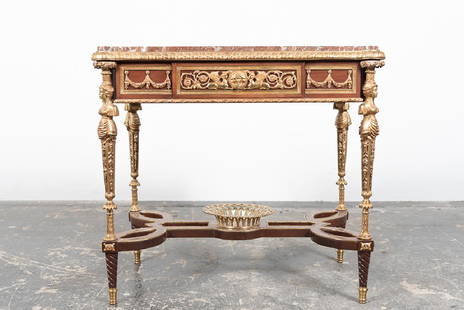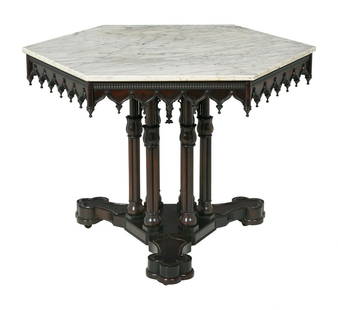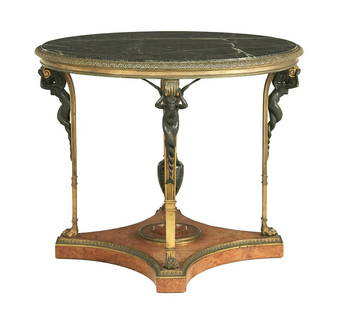
- Grooved Red Marble-Top Center Table
Similar Sale History
View More Items in Center TablesRelated Center Tables
More Items in Center Tables
View MoreRecommended Tables
View More


Item Details
Description
PROPERTY FORMERLY IN THE ROMEO JORGE COLLECTION
Grooved Red Marble-Top Center Table
last quarter of the 19th century (1875 – 1900)
red marble & “golden narra” wood (Pterocarpus indicus)
Height: 30" (76 cm) Diameter: 39 1/2" (100 cm)
PROVENANCE: Private collection, Manila.
WRITE UP:
This important center table has a red grooved marbletop on top of a simple “cenefa” apron. It is supported by a baluster base of a reeded urn (known colloquially as “kalabasa” [squash] ) over a turned circular stand with applied reeding decoration. The tripod feet emerge from the stand with foliar forms and unfurl to graceful, inwardly turning S– scrolls; the feet are secured to the stand by a flat plate. This red grooved marbletop table from the Romeo Jorge collection was famous for many years among major collectors who coveted it for its singularity; it was the only one in red marble known to exist in the whole country. Then it vanished from sight and consciousness along with the rest of the Romeo Jorge collection in the late 1990s. The only other colored ones known were the charcoal gray tabletops in the sala of Don Guido Yaptinchay y Gana and Dona Agustina Alberto y Sanchez de Carabaca in Binan, Laguna and its seeming twin in the Agra–Rivera ancestral house in Pila, Laguna. All that, until the advent of the Filipino auction houses and the unremitting repatriation of important Filipino art and antiques from Europe and the United States. Marble, whether European or Asian but always considered European, was a genuine prestige item/status symbol for prosperous Spanish–Filipino, Chinese–Filipino, or simply Filipino families during the second half of the nineteenth century. It appeared on center tables and occasional tables in grand salas as in that of Don Pedro Sy– Quia y Encarnacion and Dona Asuncion Ventura y Michels de Champourcin in Tondo (The D Pedro Sy– Quias were in the business of importing Carrara marble from Italy, among many other business ventures; the 1880s sola pieza “Table of the Sphinxes,” later sold in the 1890s to Don Placido Escudero de Leon and Dona Claudia Marasigan y Javier of San Pablo de los Montes, Laguna); appeared on dining tables in grand comedors as those of the Don Felix Pardo de Tavera y Gomez Artucha and Dona Juliana de Gorricho de los Santos family in Intramuros, and of the Angeles–David family in Bacolor, Pampanga; appeared as steps in entresuelos and azoteas as in the grand houses of Capitan Maximo Molo Agustin Paterno y Yamson and Dona Carmen Devera Ignacio y Pineda along Calle San Roque in Santa Cruz, Don Mariano Zamora and Dona Martina Molo Agustin Paterno y Yamson along Calle San Sebastian, and Don Flaviano Abreu and Dona Saturnina Salazar along Calle Sagunto in Tondo; and appeared in bathrooms as in that of Don Serafin Lazatin de Ocampo and Dona Encarnacion Singian y Torres in San Fernando, Pampanga (a thick white marble bathtub). Don Arsenio Escudero y Marasigan (+1978), a grand hacendero from San Pablo de los Montes and a younger contemporary of Jose Rizal at the Ateneo de Manila (indeed bested Jose Rizal and Juan Luna in drawing lessons by D Agustin Saez y Granadell), had a marked penchant for Italian Carrara marble --- the thicker, the better --- and added many pieces to his inheritance of the masterpiece “The Table of the Sphinxes” from his parents. He was able to acquire another long white marble table from a crumbling Intramuros palace (indeed a twin in length to “The Table of the Sphinxes”), several thick tabletops, thick benches, great urns, lifesized classical busts, and assorted items during his lifetime. Don Arsenio Escudero personified the elegant and sophisticated tastes of the late nineteenth century Filipino “ilustrado.” During the second half of the nineteenth century (1850– 1899), every big “bahay-nabato” in Luzon, Visayas, and Mindanao had two round marbletop tables with tripod bases which underscored the high social status of the homeowners, be they hacenderos (plantationowners), merchants, or both. There were essentially just two types of interchangeable baluster bases and feet: bases of reeded urns or upright acanthus leaves and the feet were of ball-and-claw or alternating C-scrolls. These center tables were usually purchased from the Sangley/Chinese master cabinetmakers along Calle Misericordia in Binondo, Manila beginning in the 1850s; the white marbletops were imported by European businessmen from Carrara, Italy and those from southern China by Chinese traders. The one with a plain molded marbletop was placed in the center of the “caida”/ entrance hall which was the family living room. The much more expensive one with multiple grooves on the sides of the marbletop --- the bigger, the more grooves, the more expensive, therefore the richer the owner (according to the Filipiniana scholar Martin Imperial Tinio Jr) --- was placed in the center of the “sala”/living room which was the formal reception room for important guests and occasions. The biggest and grandest versions known of these grooved marbletop center tables are in the Syquia mansion museum/ Don Gregorio Syquia y Encarnacion–Dona Estefania Angco estate in Vigan, Ilocos Sur (reeded urn-shaped baluster base, ball and claw feet, circa 1860); the Don Aniceto Lacson y Ledesma–Dona Rosario Araneta y Cabunsol estate in Talisay, Negros Occidental (reeded urn-shaped baluster base, ball and claw feet, circa 1880); the Museo De La Salle, DLSU-D De La Salle University-Dasmarinas, Dasmarinas, Cavite (baluster base of stylized round acanthus leaves, feet of alternating C-scrolls, Ex Coll: Jose Maria Ricardo Yaptinchay–Abad Panlilio, Angeles–Gutierrez-David estate, Bacolor, Pampanga, circa 1880); the Casa Manila house museum, Plaza San Luis, Intramuros (baluster base of upright acanthus leaves, feet of alternating C-scrolls, Ex Coll: The estates of the siblings Don Feliciano Paterno y Devera Ignacio and Dona Adelaida Paterno y Devera Ignacio, Calle Aviles, San Miguel de Tanduay, Manila; originally from the Capitan Maximo Molo Agustin Paterno y Yamson–Dona Teodora Devera Ignacio y Pineda estate, Calle San Roque, Santa Cruz, Manila, circa 1870); and in the Paulino Que and Hetty Kho collection (reeded urn-shaped baluster base, ball and claw feet, Pampanga, circa 1860), Forbes Park, Makati city.
Grooved Red Marble-Top Center Table
last quarter of the 19th century (1875 – 1900)
red marble & “golden narra” wood (Pterocarpus indicus)
Height: 30" (76 cm) Diameter: 39 1/2" (100 cm)
PROVENANCE: Private collection, Manila.
WRITE UP:
This important center table has a red grooved marbletop on top of a simple “cenefa” apron. It is supported by a baluster base of a reeded urn (known colloquially as “kalabasa” [squash] ) over a turned circular stand with applied reeding decoration. The tripod feet emerge from the stand with foliar forms and unfurl to graceful, inwardly turning S– scrolls; the feet are secured to the stand by a flat plate. This red grooved marbletop table from the Romeo Jorge collection was famous for many years among major collectors who coveted it for its singularity; it was the only one in red marble known to exist in the whole country. Then it vanished from sight and consciousness along with the rest of the Romeo Jorge collection in the late 1990s. The only other colored ones known were the charcoal gray tabletops in the sala of Don Guido Yaptinchay y Gana and Dona Agustina Alberto y Sanchez de Carabaca in Binan, Laguna and its seeming twin in the Agra–Rivera ancestral house in Pila, Laguna. All that, until the advent of the Filipino auction houses and the unremitting repatriation of important Filipino art and antiques from Europe and the United States. Marble, whether European or Asian but always considered European, was a genuine prestige item/status symbol for prosperous Spanish–Filipino, Chinese–Filipino, or simply Filipino families during the second half of the nineteenth century. It appeared on center tables and occasional tables in grand salas as in that of Don Pedro Sy– Quia y Encarnacion and Dona Asuncion Ventura y Michels de Champourcin in Tondo (The D Pedro Sy– Quias were in the business of importing Carrara marble from Italy, among many other business ventures; the 1880s sola pieza “Table of the Sphinxes,” later sold in the 1890s to Don Placido Escudero de Leon and Dona Claudia Marasigan y Javier of San Pablo de los Montes, Laguna); appeared on dining tables in grand comedors as those of the Don Felix Pardo de Tavera y Gomez Artucha and Dona Juliana de Gorricho de los Santos family in Intramuros, and of the Angeles–David family in Bacolor, Pampanga; appeared as steps in entresuelos and azoteas as in the grand houses of Capitan Maximo Molo Agustin Paterno y Yamson and Dona Carmen Devera Ignacio y Pineda along Calle San Roque in Santa Cruz, Don Mariano Zamora and Dona Martina Molo Agustin Paterno y Yamson along Calle San Sebastian, and Don Flaviano Abreu and Dona Saturnina Salazar along Calle Sagunto in Tondo; and appeared in bathrooms as in that of Don Serafin Lazatin de Ocampo and Dona Encarnacion Singian y Torres in San Fernando, Pampanga (a thick white marble bathtub). Don Arsenio Escudero y Marasigan (+1978), a grand hacendero from San Pablo de los Montes and a younger contemporary of Jose Rizal at the Ateneo de Manila (indeed bested Jose Rizal and Juan Luna in drawing lessons by D Agustin Saez y Granadell), had a marked penchant for Italian Carrara marble --- the thicker, the better --- and added many pieces to his inheritance of the masterpiece “The Table of the Sphinxes” from his parents. He was able to acquire another long white marble table from a crumbling Intramuros palace (indeed a twin in length to “The Table of the Sphinxes”), several thick tabletops, thick benches, great urns, lifesized classical busts, and assorted items during his lifetime. Don Arsenio Escudero personified the elegant and sophisticated tastes of the late nineteenth century Filipino “ilustrado.” During the second half of the nineteenth century (1850– 1899), every big “bahay-nabato” in Luzon, Visayas, and Mindanao had two round marbletop tables with tripod bases which underscored the high social status of the homeowners, be they hacenderos (plantationowners), merchants, or both. There were essentially just two types of interchangeable baluster bases and feet: bases of reeded urns or upright acanthus leaves and the feet were of ball-and-claw or alternating C-scrolls. These center tables were usually purchased from the Sangley/Chinese master cabinetmakers along Calle Misericordia in Binondo, Manila beginning in the 1850s; the white marbletops were imported by European businessmen from Carrara, Italy and those from southern China by Chinese traders. The one with a plain molded marbletop was placed in the center of the “caida”/ entrance hall which was the family living room. The much more expensive one with multiple grooves on the sides of the marbletop --- the bigger, the more grooves, the more expensive, therefore the richer the owner (according to the Filipiniana scholar Martin Imperial Tinio Jr) --- was placed in the center of the “sala”/living room which was the formal reception room for important guests and occasions. The biggest and grandest versions known of these grooved marbletop center tables are in the Syquia mansion museum/ Don Gregorio Syquia y Encarnacion–Dona Estefania Angco estate in Vigan, Ilocos Sur (reeded urn-shaped baluster base, ball and claw feet, circa 1860); the Don Aniceto Lacson y Ledesma–Dona Rosario Araneta y Cabunsol estate in Talisay, Negros Occidental (reeded urn-shaped baluster base, ball and claw feet, circa 1880); the Museo De La Salle, DLSU-D De La Salle University-Dasmarinas, Dasmarinas, Cavite (baluster base of stylized round acanthus leaves, feet of alternating C-scrolls, Ex Coll: Jose Maria Ricardo Yaptinchay–Abad Panlilio, Angeles–Gutierrez-David estate, Bacolor, Pampanga, circa 1880); the Casa Manila house museum, Plaza San Luis, Intramuros (baluster base of upright acanthus leaves, feet of alternating C-scrolls, Ex Coll: The estates of the siblings Don Feliciano Paterno y Devera Ignacio and Dona Adelaida Paterno y Devera Ignacio, Calle Aviles, San Miguel de Tanduay, Manila; originally from the Capitan Maximo Molo Agustin Paterno y Yamson–Dona Teodora Devera Ignacio y Pineda estate, Calle San Roque, Santa Cruz, Manila, circa 1870); and in the Paulino Que and Hetty Kho collection (reeded urn-shaped baluster base, ball and claw feet, Pampanga, circa 1860), Forbes Park, Makati city.
Buyer's Premium
- 25.16%
- Grooved Red Marble-Top Center Table
Estimate ₱260,000 - ₱338,000
Shipping & Pickup Options
Item located in Makati City, Metro Manila, phSee Policy for Shipping
Payment

TOP















































































